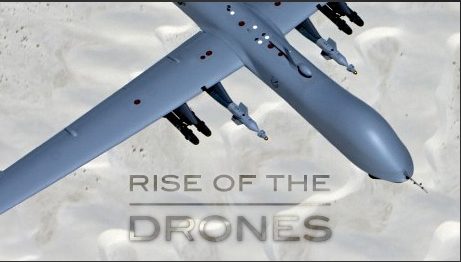
On January 23, PBS aired a much-hyped documentary on the increasing presence of drones. The program, part of the NOVA Science series, is called Rise of the Drones, and the promotional material produced by PBS said the program shows
the amazing technologies that make drones so powerful as we see how a remotely-piloted drone strike looks and feels from inside the command center. From cameras that can capture every detail of an entire city at a glance to swarming robots that can make decisions on their own to giant air frames that can stay aloft for days on end, drones are changing our relationship to war, surveillance, and each other.
As the documentary began, PBS ran a list of benefactors who helped make the production possible. Included in that credit roll was Lockheed Martin.
Lockheed Martin is the nation’s second-largest defense contractor, earning billions annually in revenues from government contracts. In 2009, for example, 74 percent of Lockheed Martin’s total revenue came from military sales.
Therein lies the problem, according to a recent investigative report by Kevin Gosztola.
Gosztola writes that in accepting Lockheed Martin’s contribution to the NOVA drone documentary, PBS may have violated its own underwriting guidelines. In the article Gosztola reports that there is a three-prong test for accepting funding.
First, PBS must determine whether the underwriter (Lockheed Martin, in this case) has exercised any level of “editorial control” over the content of the program.
Second, is it possible that the public could perceive that the underwriter had exercised editorial control?
And finally, “might the public conclude the program is on PBS principally because it promotes the underwriter’s products, services, or other business interests?”
On its face, the Rise of the Drones documentary fails at least the last two prongs of the underwriting protocols.
As quoted above, the description of the program is fawning and could have been copied and pasted from Lockheed Martin’s own promotional materials.
A crucial question, however, is whether Lockheed Martin makes drones or any of the technology used in them.
Take this story from Aviation Week published last December. The article reports on an as-yet classified Lockheed Martin project to develop stealth drones. For example, the author reports that, “in late 2001 or early 2002 Lockheed Martin was awarded a contract for a simpler, medium-altitude tactical stealth UAV [Unmanned Aerial Vehicle], which became the RQ-170 Sentinel.”
That alone would seem to prevent Lockheed Martin from being permitted to fund a PBS drone documentary as it might be perceived a promotion of Lockheed Martin’s products.
Additionally, Gosztola makes the following point regarding the possible conflict of interest:
In 2008, Lockheed Martin teamed up with Karem Aircraft Incorporated to develop “Karem Aircraft’s Optimum Speed Tilt-Rotor (OSTR) design.” It was “one of three approaches selected by the Department of Defense (DoD) Joint Heavy Lift program office to receive a Concept Design and Analysis extension contract.” Karem Aircraft Incorporated was founded by Abe Karem. He appears in the documentary and, as The Economist has described him, he is the man who “created the robotic plane that transformed the way modern warfare is waged — and continues to pioneer other airborne innovations.” Karem talks about the advancement and benefits of drone technology. This is a clear conflict of interest.
A fair viewing of the Rise of the Drones NOVA special does give the impression that PBS is going out of its way to make the impending ubiquity of these all-seeing, government-owned and -controlled eyes-in-the-sky seem much more palatable.
As The New American has reported, the Federal Aviation Administration (FAA) predicts that by 2020, 30,000 of these unmanned aerial vehicles will be patrolling American airspace.
While that mass deployment awaits Americans, the constant buzz of drones is already a part of everyday life for people in Yemen and Pakistan, where the drones are used to deliver death.
The London-based advocacy group the Bureau for Investigative Journalism recently reported that there have been at least 350 U.S. drone strikes in Pakistan since 2004. Nearly 300 of these occurred after the 2009 inauguration of President Barack Obama. As many as 885 innocent civilians — including 176 children — have been needlessly, summarily, and callously killed in drone strikes ordered by the White House and the CIA.
Then, there is the NYU/Stanford report entitled “Living Under Drones: Death, Injury and Trauma to Civilians From US Drone Practices in Pakistan,” which contains tragic details of the myriad ways that President Obama’s death-by-drone program is devastating the lives of ordinary Pakistanis who have no connection to terror other than the fact that they are being constantly terrorized by the government of the United States.
Information contained in that report indicate that only two percent of drone strikes result in the death of known leaders of terrorist organizations.
What has the United States’ drone war wrought? Peace? A reduction in the number of suspected militants formulating plans to attack the United States, its people, or its interests at home or overseas?
Regardless of these disturbing aspects of the drone war, the Rise of the Drones documentary paints the pilots of these remote-control weapons as “heroes” and muses that someday there will come a time “when machines can fly, think and even kill on their own.”
One would expect that such a scenario would be described with appropriately sombre music. That is, unless the movie was being funded by a company poised to make billions from the expansion of the devices and the technology making them ever deadlier and more difficult to detect.
Finally, were Rise of the Drones more of an informative documentary and less of a commercial for a multi-billion-dollar defense contractor, perhaps viewers would have been presented with some of the difficult questions surrounding the crescendo of drone deployment.
For example, not a word is mentioned regarding the application of the Fourth Amendment’s guarantee of the people “to be secure in their persons, houses, papers, and effects, against unreasonable searches and seizures” and these airborne surveillance vehicles.
And what of the fact that a presidential presumption of guilt by association is often followed by an autocratic order of a lethal drone strike that kills unnamed, unidentified, and uncounted targets. NOVA didn’t ask why these alleged “terrorists” cannot be tried in our federal court system. For decades those accused of terroristic crimes have been formally charged with those crimes, had those charges heard before an impartial federal judge, and been permitted to mount a defense to those crimes.
Once in the custody of the United States, these suspects could be brought to stand trial for their alleged crimes. This would preserve, protect, and defend the fundamental concept of due process, one of the pillars of liberty upon which our Constitution is built.
None of these difficult topics is ever broached by PBS and the filmmakers. In fact, it is this lack combined with the rah-rah tone of the program that elicits questions of the independence of PBS and the possibility that it violated its own published protocols to produce a highly-polished commercial for a defense contractor using that contractor’s money.
In addition to funding from Lockheed Martin and other corporations, PBS receives about $446 million in funding annually from the American taxpayer.
PBS has not responded to email requests for comment from The New American.
Graphic: Rise of the Drones promotional photo
Joe A. Wolverton, II, J.D. is a correspondent for The New American and travels frequently nationwide speaking on topics of nullification, the NDAA, and the surveillance state. He can be reached at [email protected].



